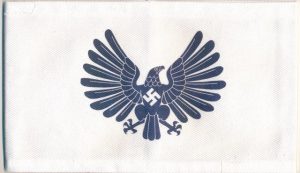WWII German Red Reichsbahn Railway Officers Visor
$65.00
1 in stock
WWII German Reichsbahn Railway Officers Visor. This is an amazing visor cap in size 61 with gold insignia, it features the Erel Sonderklasse sweat shield, Erel marked leather sweat band, and the ventilation holes, and the Reichsbahn chin strap (the different colors of Reichsbahn chin straps indicate paygrade).
The Deutsche Reichsbahn (German National Railway) was the state-owned railway company during the Third Reich and a crucial component of Nazi Germany’s war machine. During WWII, it was essential for military logistics, industrial transport, and the systematic mass deportation of millions of people to concentration and extermination camps.
While officially a civilian commercial entity, the Reichsbahn was placed under the control of the German Army General Staff’s Transportation Division during wartime. It seamlessly integrated into the Nazi regime’s military and political goals.
The railway system was vital to Germany’s blitzkrieg strategy and expansionist campaigns. It allowed for the rapid movement of troops, tanks, and supplies during the invasion of Austria (1938), Czechoslovakia (1939), Poland (1939), and France (1940).
As Germany occupied new territories, the Reichsbahn took control of the local railways, integrating them into the larger German system. This included the railway networks of Alsace-Lorraine and parts of Poland.
The Reichsbahn produced specialized wagons, known as Kriegsbauart, which were simpler and cheaper to build in wartime for military logistics. This included heavy rail flats for transporting tanks.
The Reichsbahn played a central and integral role in the logistics of the Holocaust.
The Reichsbahn profited financially from the deportations by charging the victims a “third-class fare” for their journey to the death camps. These payments helped fund the Nazi regime.
As the war progressed, the Reichsbahn became a major target for resistance and sabotage efforts across occupied Europe.
Partisan attacks: Organized resistance groups and railway workers attacked railway infrastructure, destroyed tracks, and misdirected trains to disrupt German military operations.
Railway gauge issues: In the Eastern Front, the wider railway gauge used by the Soviet Union initially posed a major logistical problem for the Germans. This was one of many factors that hindered the Reichsbahn’s effectiveness in the east.
Related products
Armbands




















